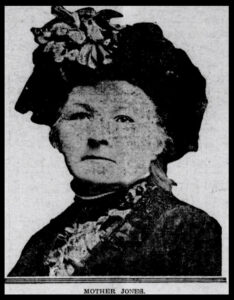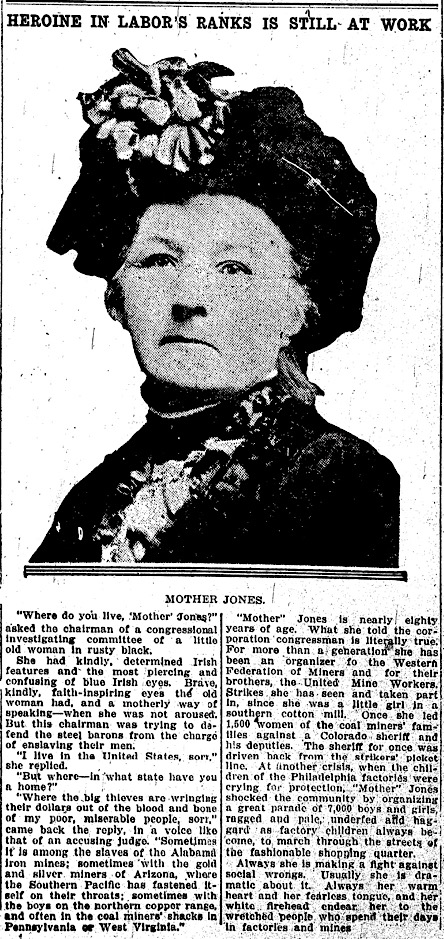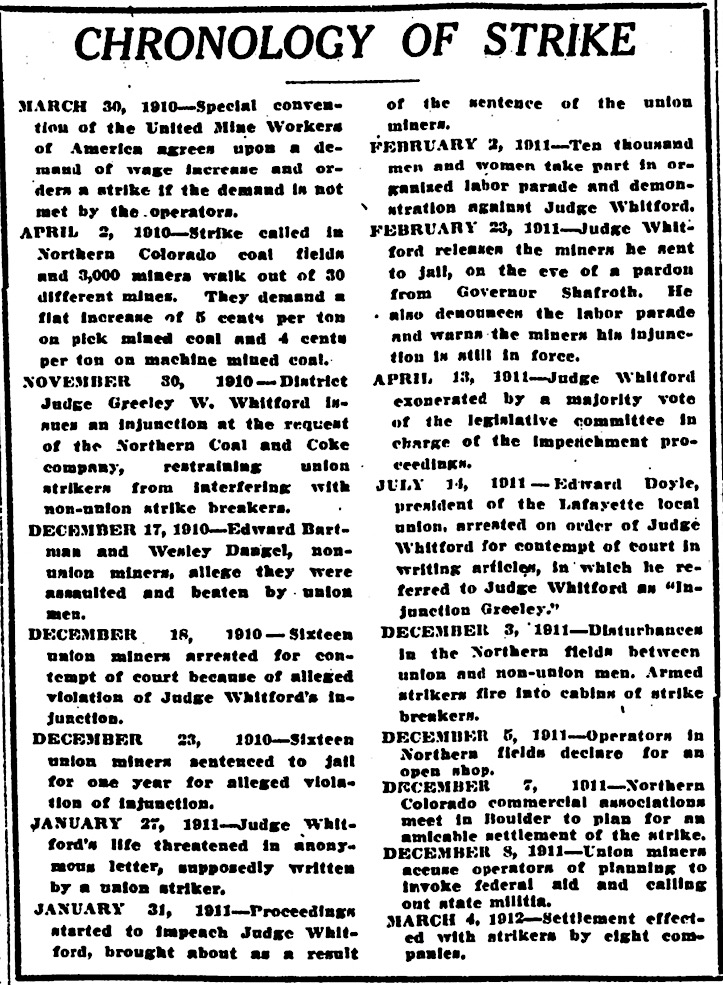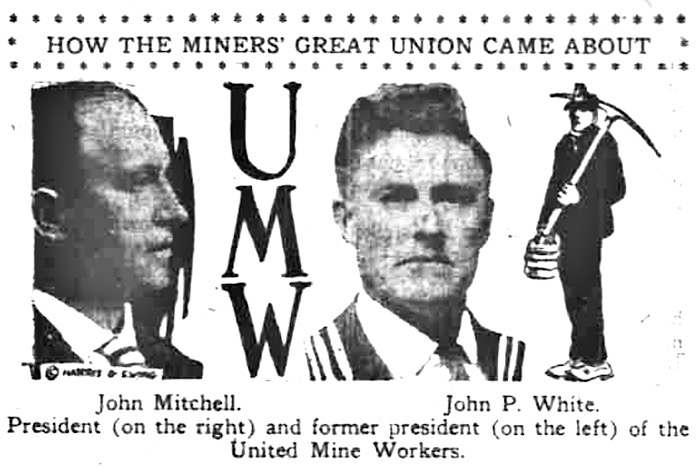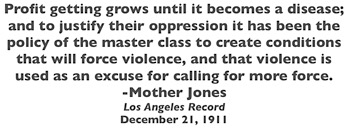 —————
—————
Hellraisers Journal – Monday April 15, 1912
Mother Jones News Round-Up for March 1912, Part I
Found in Illinois, Denver, Colorado and Tacoma, Washington
From The Sibley Journal of March 1, 1912:
Walker to Head Miners.
The closing day of the Illinois Mine Workers’ state convention was featured by the announcement of election from the vote held December 14, 1911.
It was generally thought at that time that all the officers would be re-elected. There was but one exception in this, Paul Smith defeating Adolph Germer for the vice presidency. President Walker and Secretary Treasurer McDonald were re-elected by large majorities…..
Aside from the announcement of the election results, a two-hour address by ”Mother” Jones, a woman, eighty years old, who is a Socialist lecturer of national prominence and called the “Miners’ Mascot,” in which she denounced woman suffrage, was the feature. She declared that women are not mentally equipped to acquire a proper knowledge of politics, and she attributed the defeat of the recall in Colorado to the women voters. In closing her address, “Mother” Jones detailed the conditions brought about by the railroad strike in Colorado and asked the miners of Illinois to donate a benefit fund of $1,000 to the strikers. A committee was named to investigate the matter…..
[Photograph added.]
From The Illinois State Journal of March 2, 1912:
From the Denver Rocky Mountain News of March 5, 1912:
NORTHERN COLORADO COAL
STRIKE ENDS IN 8 MINES
———-6 KILLED, 10 MAIMED 100 BEATEN,
BLOODY RECORD OF WAR
———-
Strikebreakers’ Refusals to Quit Fields Cause
of Most Serious Outbreaks.
———-“Six men killed, ten maimed for life and more than 100 waylaid and beaten.” This is the record of bitterness between the opposing forces of the labor war in the Northern coal were from the ranks of both strikers and strike breakers…..
One of the striking features of the struggle occurred a few months ago, when “Mother Jones,” a well known national figure in the labor world, went into the district to organize the wives and sisters of the striking miners. She received an enthusiastic reception, but when the women attempted to carry out their ideas the strikers objected so strenuously that they were forced to abandon their militant plans for a campaign.
———-
From the Denver United Labor Bulletin of March 21, 1912:
“MOTHER” JONES LEAVES DENVER.
———-“Mother” Jones, who has been in Denver for several days, addressed the Federated Shopmen in their convention in Machinists’ hall this week. She is preparing to tour the northwest in the interests of the shopmen. She will go to Tacoma and then travel East as far as St. Paul.
From The Tacoma Sunday Ledger of March 24, 1912:
SOCIALISTS PRESENT DIVERSE ATTRACTIONS
———-
Mother Jones Holds Forth in One Place,
Candidates in Another, Entertainment Held Afterwards.
———-With “Mother” Jones, a national character among labor organizations addressing a crowd in one part of Eagles’ hall and with Mrs. Kate Sadler of Seattle, together with J. R. Oman. A. H. Barth and D. E. McPherson, candidates for municipal commissionerships, speaking in another part of the hall, local socialists entertained a large number of members and visitors last night. After almost two hours of oratory from “Mother” Jones the upstairs meeting adjourned, but not until the hats were passed around and a contribution to pay the expenses of the hall received. It was then announced that the candidates for city positions would speak at an entertainment in the downstairs hall, where an admission of 25 cents would be charged. It was understood the sum would be devoted to printing campaign literature on behalf of the candidates
Mother Jones is 80 years of age and an organizer for the Western Federation of Miners. She told of her fights in the principal coal strikes of the country and was loudly applauded.
———-
From the Chicago Day Book of March 26, 1912:
By Max Hayes.
When John Siney, an Ohio man, organized and became president of the first national union of miners, about 40 years ago, he dreamed that some day the child of his brain and tireless labors would become sufficiently powerful to exercise an influence in shaping the working conditions of the men who were compelled to spend nearly one-half of their lives, in the stygian darkness of the earth’s bowels, and perhaps ultimately dominate the mining industry as a whole.
The first union started out with less than 25,000 men enrolled, and when the Knights of Labor became a power in the 80’s they organized what became known as national trades assembly No., 135, the mining division.
When the K. of L. began to disintegrate after the great south west strike and other disastrous contests, and the famous Richmond convention, an agitation developed among the miners to combine Assembly No. 135 and the National Progressive union, which occurred in January, 1890, when John McRae of Ohio was chosen president of the United Mine Workers of America.
But owing to unsuccessful local strikes, lose methods of organization, business depression and other industrial ills the miner’ organization was no stronger two years later than when Siney formed the first national union.
The real growth of the U. M. W. began about 15 years ago, after M. D. Ratchford of Ohio assumed the leadership, although it was slow progress. John Mitchell followed Ratchford and, aided by Mother Jones, W. B. Wilson (now congressman from Pennsylvania), Tom Lewis and W. D. Ryan, and the younger men who are now at the helm-John P. White, Frank Hayes, John Walker and others-the organization grew in leaps and bounds, until today over 300,000 men are enrolled.
The winning of the big strike in Illinois a dozen years ago-in which the issue was clearly defined as to unionism probably had more to do than any other single incident to guarantee the growth of the U. M. W.
The greatest strike in the organization’s history occurred two years ago, when about 300,000 men walked out of the bituminous mines. The strike was for more wages and was settled by districts favorably to the men, Iowa and Michigan leading off after a few weeks’ shut-down, with other states falling in line, Illinois being the last to yield after nearly six months of battling.
The anthracite strike of 1902 brought out 160,000 men, nearly all of whom remained idle for a period of over five months. The Roosevelt anthracite strike commission awarded the miners the nine-hour day and 10 per cent more wages, but enforced the open shop. The latter provision in the award has proven a serious handicap to the U. M. W. Officials claim that hundreds of active unionists have been blacklisted, resulting in thousands of others being intimidated and forced to desert the organization.
Baer, Truesdale and other operators claim that White really doesn’t represent more than 25,000 organized anthracite men, or about 15 per cent, in the three districts. This is doubtless true, thanks to the effectiveness of their coercive methods.
But John Mitchell represented less-than 20,000 men when the strike was called ten years ago. In the big Illinois strike only 11,000 men were in the union when the fight began and 75,000 were enrolled when it ended. When 30,000 miners quit work in the Westmoreland field three years ago-and battled over one year only a handful were organized.
A peculiar feature about the miners is that almost invariably the non-unionists follow the lead of the unionists. The only exception to the rule has been in West Virginia, where the non-union men are held in servitude like so many serfs by the Davises and Elkinses and other feudal barons.
If John P. White can inaugurate a campaign that will result in freeing the slaves of the mines in West Virginia the dream of John Siney will be in a fair way to become a reality.
—————
Note: Emphasis added throughout.
~~~~~~~~~~~~~~~~~~~~~~~~~
SOURCES & IMAGES
Quote Mother Jones Master Class Creates Violence, LA Rec p4, Dec 21, 1911
https://www.newspapers.com/image/677905184/
The Sibley Journal
(Sibley, Illinois)
-Mar 1, 1912, p2
https://www.newspapers.com/image/354852562/
The Illinois State Journal
(Springfield, Illinois)
-Mar 2, 1912, p2
https://www.genealogybank.com/
The Rocky Mountain News
(Denver, Colorado)
-Mar 5, 1912, p2
https://www.genealogybank.com/
United Labor Bulletin
(Denver, Colorado)
-Mar 21, 1912
https://chroniclingamerica.loc.gov/lccn/sn91052295/1912-03-21/ed-1/seq-2/
The Tacoma Sunday Ledger
(Tacoma, Washington)
-Mar 24, 1912, ;5
https://www.newspapers.com/image/724953458/
The Day Book
(Chicago, Illinois)
-Mar 26, 1912
https://chroniclingamerica.loc.gov/lccn/sn83045487/1912-03-26/ed-1/seq-19/
IMAGE
Mother Jones, Tacoma Tx p3, Feb 14, 1912
https://chroniclingamerica.loc.gov/lccn/sn88085187/1912-02-14/ed-1/seq-3/
See also:
Hellraisers Journal: Whereabouts and Doings of Mother Jones for February 1912
Part I: Found in Colorado, Wyoming, Illinois, Ohio and Indianapolis, Indiana
Part II: Four Score Hard Winters of Labor’s Heroine Described by Lawrence Todd
The Northern Colorado Coal Strike of 1910-1912
can be followed here, see issues from April 1910 to April 1912:
https://chroniclingamerica.loc.gov/lccn/sn91052295/issues/1909/
Tag: Illinois Central and Harriman Lines Strike of 1911 to 1915
https://weneverforget.org/tag/illinois-central-and-harriman-lines-strike-of-1911-to-1915/
John Siney
https://spartacus-educational.com/USAsiney.htm
History of United mine workers of America
from the year 1860 to 1890
-by Chris Evans.
UMWA, (1917-1919, while Frank Hayes was president, see intro)
https://catalog.hathitrust.org/Record/101821370
A brief history of the United Mine Workers of America.
-by Justin McCarthy
UMWJ, 1956
https://catalog.hathitrust.org/Record/009694265
~~~~~~~~~~~~~~~~~~~~~~~~~
Children of Mother Jones by Pete Duffy

